Marketing Management & Digital Communication - PDF
VerifiedAdded on 2021/06/17
|15
|3792
|60
AI Summary
Contribute Materials
Your contribution can guide someone’s learning journey. Share your
documents today.
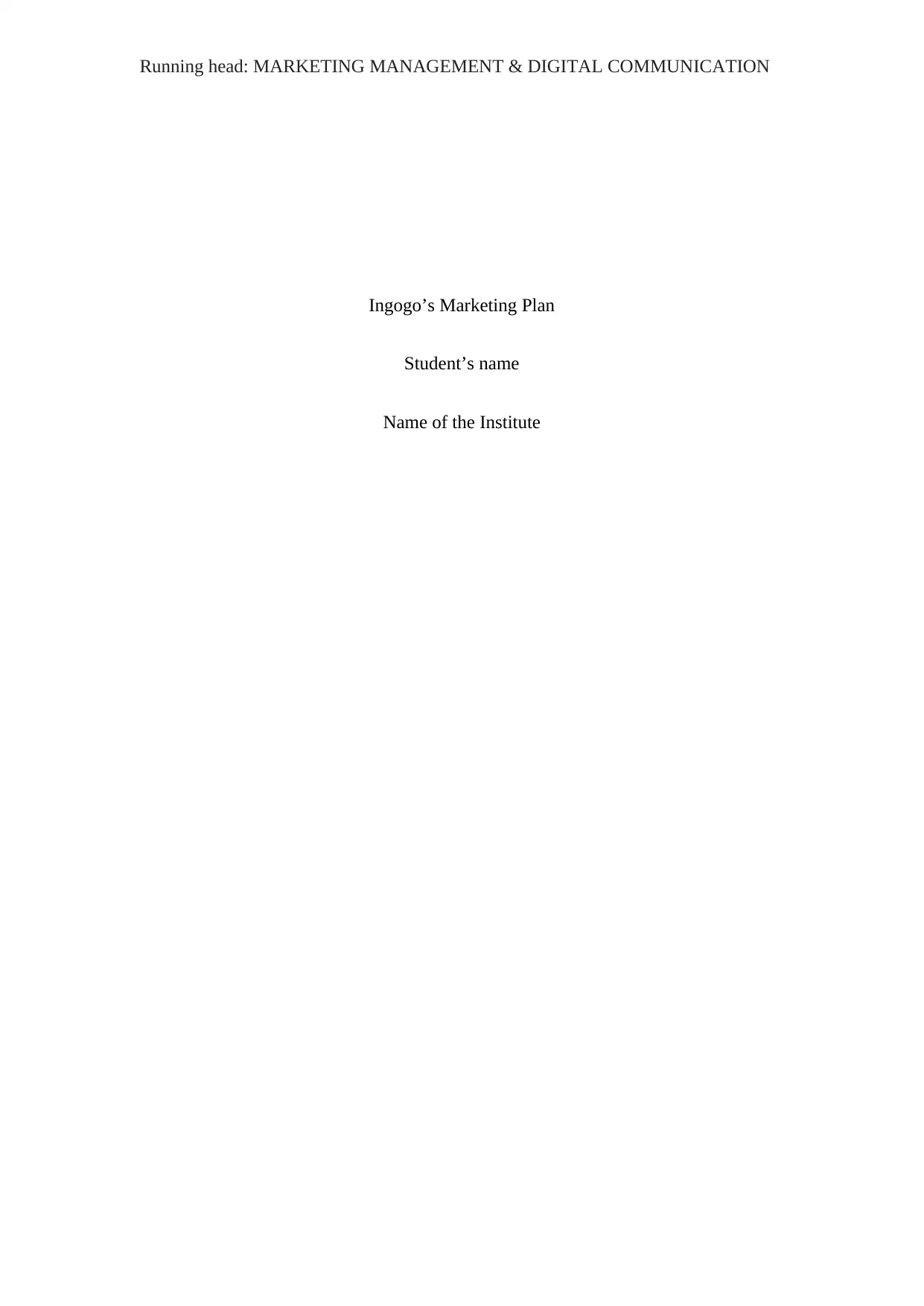
Running head: MARKETING MANAGEMENT & DIGITAL COMMUNICATION
Ingogo’s Marketing Plan
Student’s name
Name of the Institute
Ingogo’s Marketing Plan
Student’s name
Name of the Institute
Secure Best Marks with AI Grader
Need help grading? Try our AI Grader for instant feedback on your assignments.
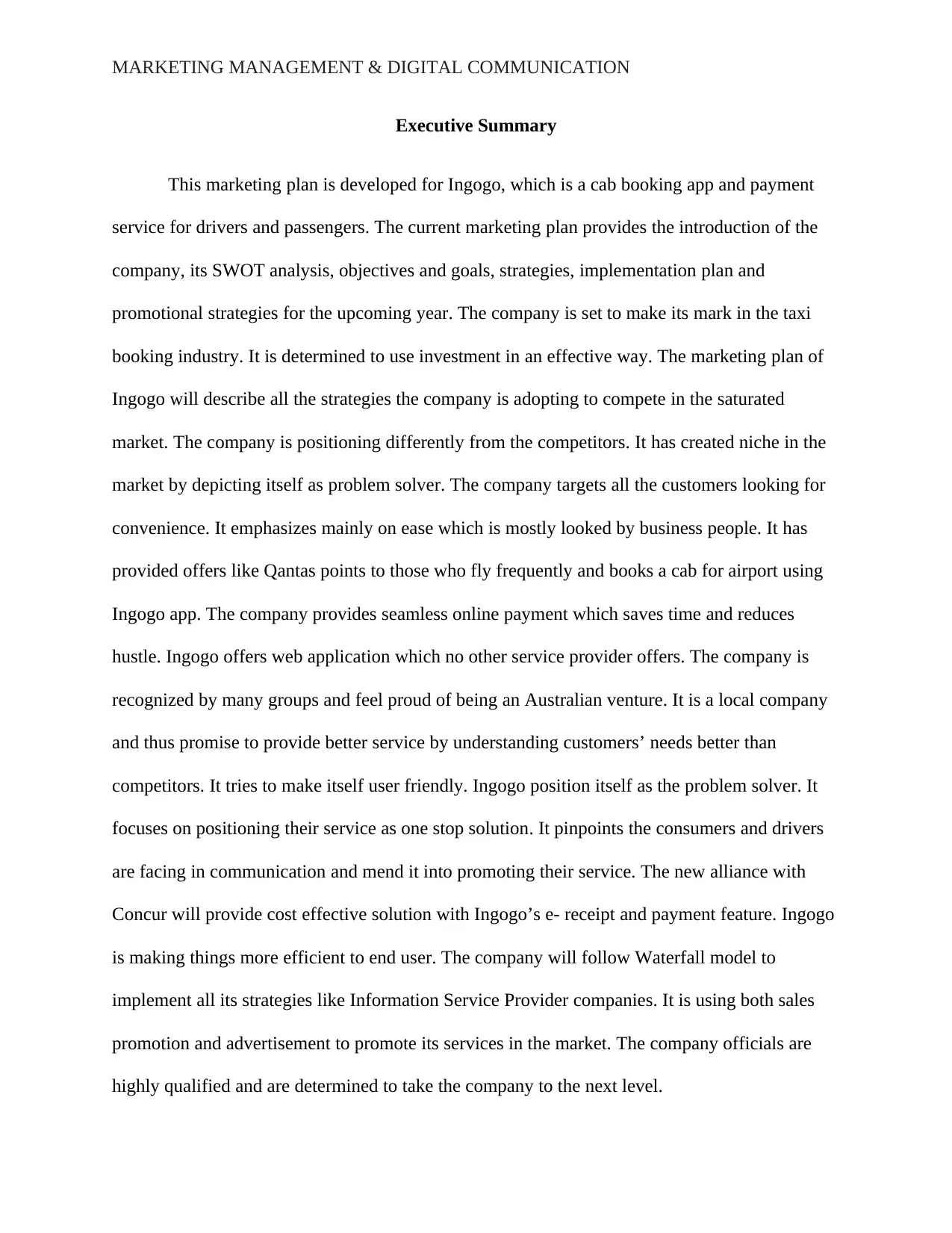
MARKETING MANAGEMENT & DIGITAL COMMUNICATION
Executive Summary
This marketing plan is developed for Ingogo, which is a cab booking app and payment
service for drivers and passengers. The current marketing plan provides the introduction of the
company, its SWOT analysis, objectives and goals, strategies, implementation plan and
promotional strategies for the upcoming year. The company is set to make its mark in the taxi
booking industry. It is determined to use investment in an effective way. The marketing plan of
Ingogo will describe all the strategies the company is adopting to compete in the saturated
market. The company is positioning differently from the competitors. It has created niche in the
market by depicting itself as problem solver. The company targets all the customers looking for
convenience. It emphasizes mainly on ease which is mostly looked by business people. It has
provided offers like Qantas points to those who fly frequently and books a cab for airport using
Ingogo app. The company provides seamless online payment which saves time and reduces
hustle. Ingogo offers web application which no other service provider offers. The company is
recognized by many groups and feel proud of being an Australian venture. It is a local company
and thus promise to provide better service by understanding customers’ needs better than
competitors. It tries to make itself user friendly. Ingogo position itself as the problem solver. It
focuses on positioning their service as one stop solution. It pinpoints the consumers and drivers
are facing in communication and mend it into promoting their service. The new alliance with
Concur will provide cost effective solution with Ingogo’s e- receipt and payment feature. Ingogo
is making things more efficient to end user. The company will follow Waterfall model to
implement all its strategies like Information Service Provider companies. It is using both sales
promotion and advertisement to promote its services in the market. The company officials are
highly qualified and are determined to take the company to the next level.
Executive Summary
This marketing plan is developed for Ingogo, which is a cab booking app and payment
service for drivers and passengers. The current marketing plan provides the introduction of the
company, its SWOT analysis, objectives and goals, strategies, implementation plan and
promotional strategies for the upcoming year. The company is set to make its mark in the taxi
booking industry. It is determined to use investment in an effective way. The marketing plan of
Ingogo will describe all the strategies the company is adopting to compete in the saturated
market. The company is positioning differently from the competitors. It has created niche in the
market by depicting itself as problem solver. The company targets all the customers looking for
convenience. It emphasizes mainly on ease which is mostly looked by business people. It has
provided offers like Qantas points to those who fly frequently and books a cab for airport using
Ingogo app. The company provides seamless online payment which saves time and reduces
hustle. Ingogo offers web application which no other service provider offers. The company is
recognized by many groups and feel proud of being an Australian venture. It is a local company
and thus promise to provide better service by understanding customers’ needs better than
competitors. It tries to make itself user friendly. Ingogo position itself as the problem solver. It
focuses on positioning their service as one stop solution. It pinpoints the consumers and drivers
are facing in communication and mend it into promoting their service. The new alliance with
Concur will provide cost effective solution with Ingogo’s e- receipt and payment feature. Ingogo
is making things more efficient to end user. The company will follow Waterfall model to
implement all its strategies like Information Service Provider companies. It is using both sales
promotion and advertisement to promote its services in the market. The company officials are
highly qualified and are determined to take the company to the next level.
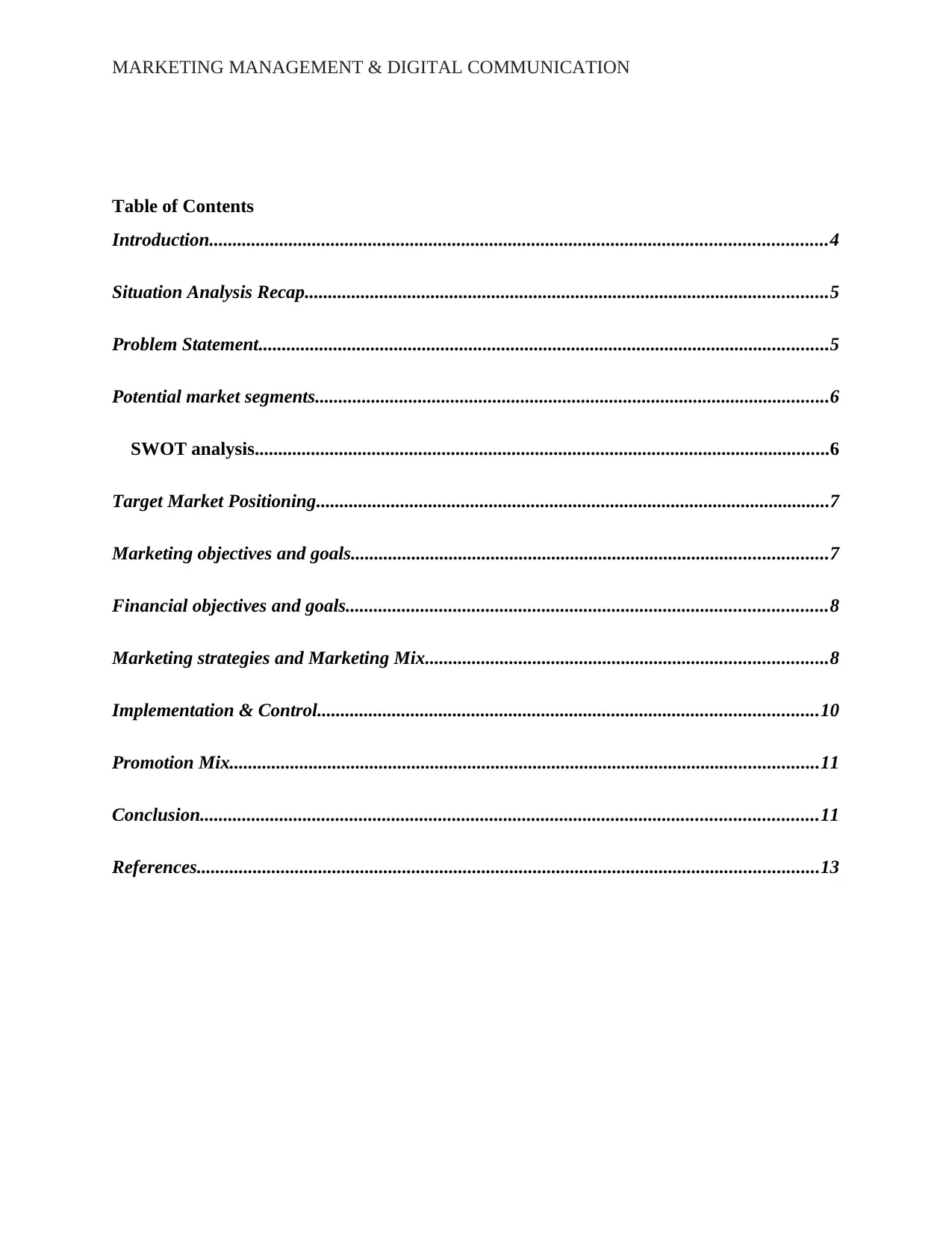
MARKETING MANAGEMENT & DIGITAL COMMUNICATION
Table of Contents
Introduction....................................................................................................................................4
Situation Analysis Recap................................................................................................................5
Problem Statement..........................................................................................................................5
Potential market segments..............................................................................................................6
SWOT analysis...........................................................................................................................6
Target Market Positioning..............................................................................................................7
Marketing objectives and goals......................................................................................................7
Financial objectives and goals.......................................................................................................8
Marketing strategies and Marketing Mix......................................................................................8
Implementation & Control...........................................................................................................10
Promotion Mix..............................................................................................................................11
Conclusion....................................................................................................................................11
References.....................................................................................................................................13
Table of Contents
Introduction....................................................................................................................................4
Situation Analysis Recap................................................................................................................5
Problem Statement..........................................................................................................................5
Potential market segments..............................................................................................................6
SWOT analysis...........................................................................................................................6
Target Market Positioning..............................................................................................................7
Marketing objectives and goals......................................................................................................7
Financial objectives and goals.......................................................................................................8
Marketing strategies and Marketing Mix......................................................................................8
Implementation & Control...........................................................................................................10
Promotion Mix..............................................................................................................................11
Conclusion....................................................................................................................................11
References.....................................................................................................................................13
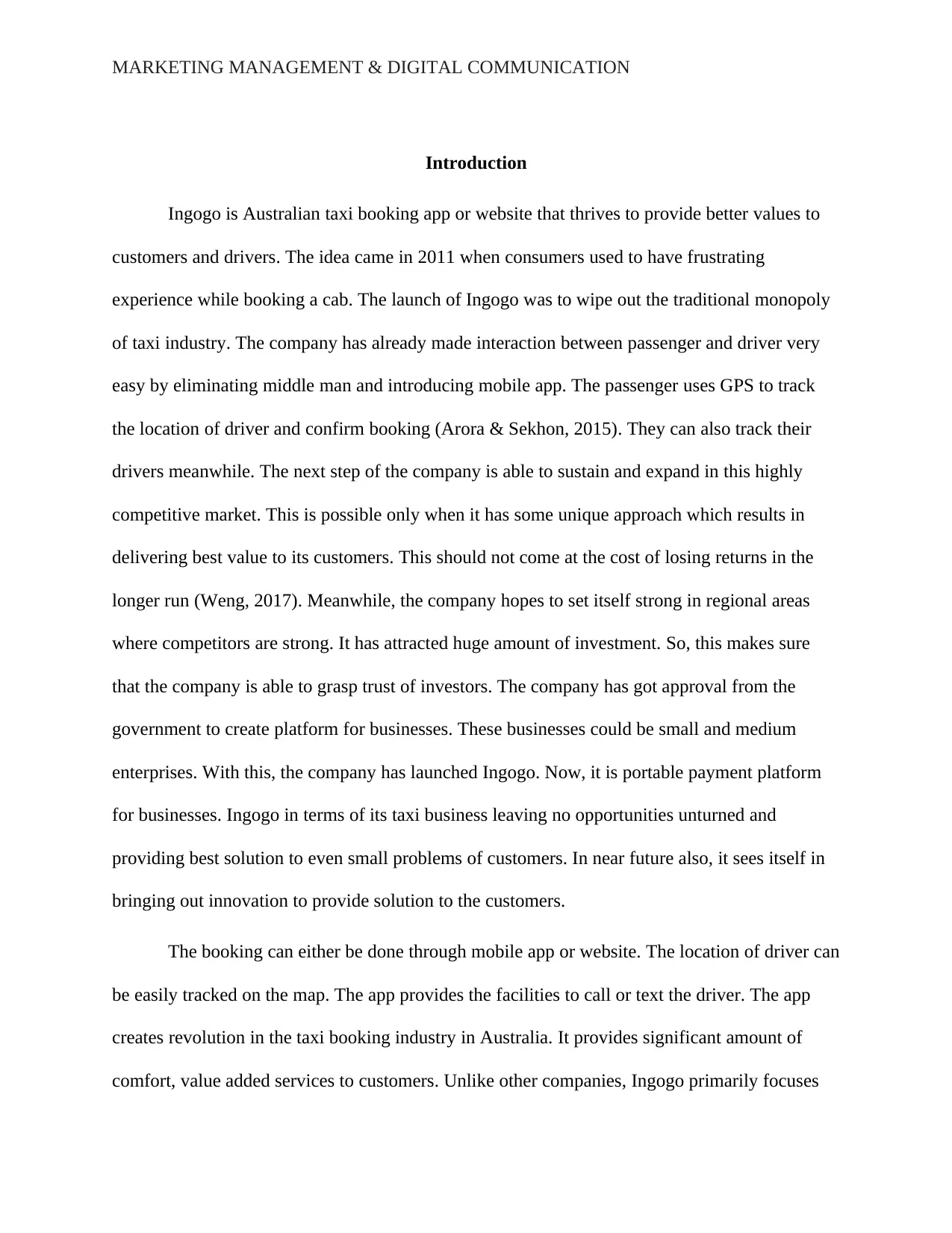
MARKETING MANAGEMENT & DIGITAL COMMUNICATION
Introduction
Ingogo is Australian taxi booking app or website that thrives to provide better values to
customers and drivers. The idea came in 2011 when consumers used to have frustrating
experience while booking a cab. The launch of Ingogo was to wipe out the traditional monopoly
of taxi industry. The company has already made interaction between passenger and driver very
easy by eliminating middle man and introducing mobile app. The passenger uses GPS to track
the location of driver and confirm booking (Arora & Sekhon, 2015). They can also track their
drivers meanwhile. The next step of the company is able to sustain and expand in this highly
competitive market. This is possible only when it has some unique approach which results in
delivering best value to its customers. This should not come at the cost of losing returns in the
longer run (Weng, 2017). Meanwhile, the company hopes to set itself strong in regional areas
where competitors are strong. It has attracted huge amount of investment. So, this makes sure
that the company is able to grasp trust of investors. The company has got approval from the
government to create platform for businesses. These businesses could be small and medium
enterprises. With this, the company has launched Ingogo. Now, it is portable payment platform
for businesses. Ingogo in terms of its taxi business leaving no opportunities unturned and
providing best solution to even small problems of customers. In near future also, it sees itself in
bringing out innovation to provide solution to the customers.
The booking can either be done through mobile app or website. The location of driver can
be easily tracked on the map. The app provides the facilities to call or text the driver. The app
creates revolution in the taxi booking industry in Australia. It provides significant amount of
comfort, value added services to customers. Unlike other companies, Ingogo primarily focuses
Introduction
Ingogo is Australian taxi booking app or website that thrives to provide better values to
customers and drivers. The idea came in 2011 when consumers used to have frustrating
experience while booking a cab. The launch of Ingogo was to wipe out the traditional monopoly
of taxi industry. The company has already made interaction between passenger and driver very
easy by eliminating middle man and introducing mobile app. The passenger uses GPS to track
the location of driver and confirm booking (Arora & Sekhon, 2015). They can also track their
drivers meanwhile. The next step of the company is able to sustain and expand in this highly
competitive market. This is possible only when it has some unique approach which results in
delivering best value to its customers. This should not come at the cost of losing returns in the
longer run (Weng, 2017). Meanwhile, the company hopes to set itself strong in regional areas
where competitors are strong. It has attracted huge amount of investment. So, this makes sure
that the company is able to grasp trust of investors. The company has got approval from the
government to create platform for businesses. These businesses could be small and medium
enterprises. With this, the company has launched Ingogo. Now, it is portable payment platform
for businesses. Ingogo in terms of its taxi business leaving no opportunities unturned and
providing best solution to even small problems of customers. In near future also, it sees itself in
bringing out innovation to provide solution to the customers.
The booking can either be done through mobile app or website. The location of driver can
be easily tracked on the map. The app provides the facilities to call or text the driver. The app
creates revolution in the taxi booking industry in Australia. It provides significant amount of
comfort, value added services to customers. Unlike other companies, Ingogo primarily focuses
Secure Best Marks with AI Grader
Need help grading? Try our AI Grader for instant feedback on your assignments.
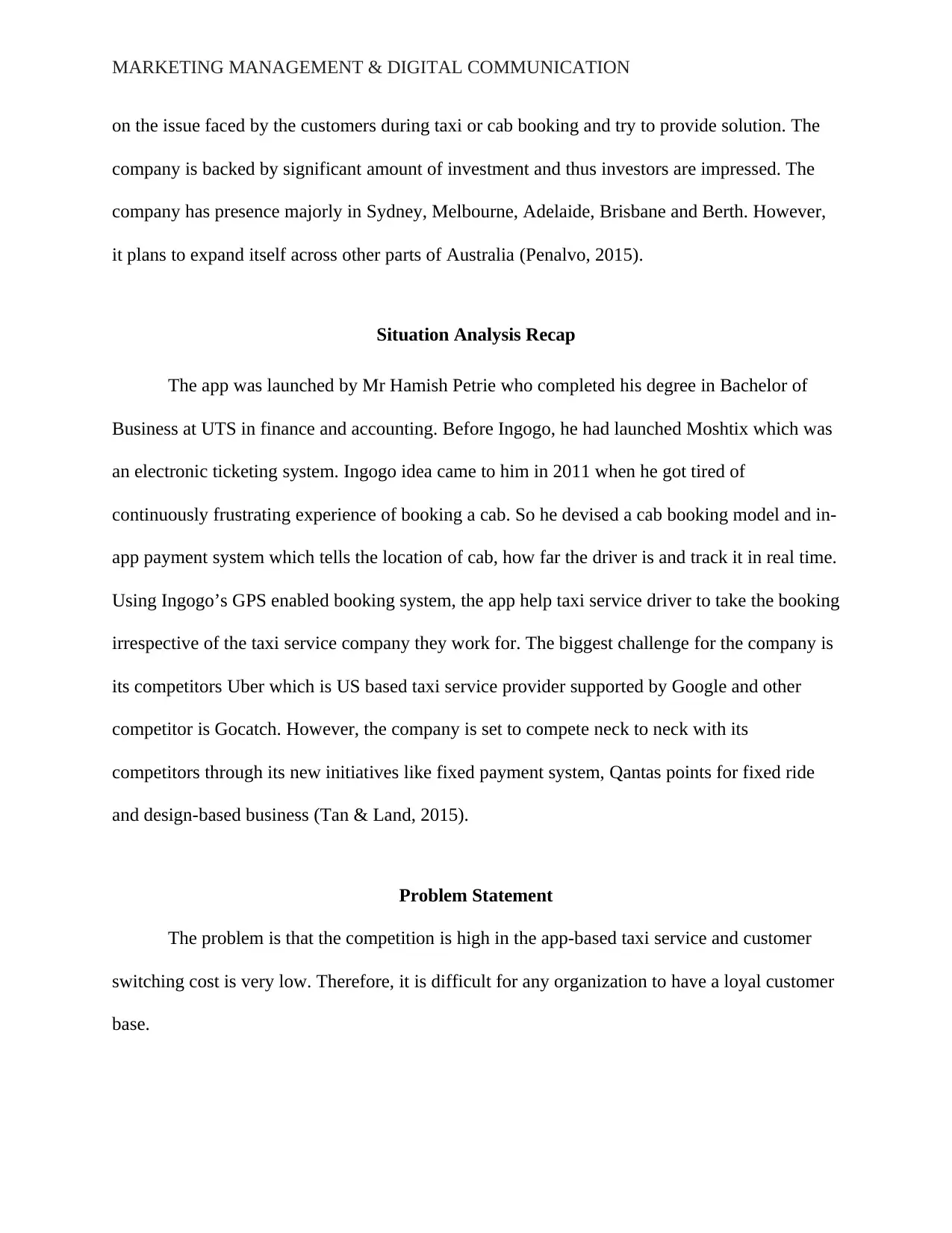
MARKETING MANAGEMENT & DIGITAL COMMUNICATION
on the issue faced by the customers during taxi or cab booking and try to provide solution. The
company is backed by significant amount of investment and thus investors are impressed. The
company has presence majorly in Sydney, Melbourne, Adelaide, Brisbane and Berth. However,
it plans to expand itself across other parts of Australia (Penalvo, 2015).
Situation Analysis Recap
The app was launched by Mr Hamish Petrie who completed his degree in Bachelor of
Business at UTS in finance and accounting. Before Ingogo, he had launched Moshtix which was
an electronic ticketing system. Ingogo idea came to him in 2011 when he got tired of
continuously frustrating experience of booking a cab. So he devised a cab booking model and in-
app payment system which tells the location of cab, how far the driver is and track it in real time.
Using Ingogo’s GPS enabled booking system, the app help taxi service driver to take the booking
irrespective of the taxi service company they work for. The biggest challenge for the company is
its competitors Uber which is US based taxi service provider supported by Google and other
competitor is Gocatch. However, the company is set to compete neck to neck with its
competitors through its new initiatives like fixed payment system, Qantas points for fixed ride
and design-based business (Tan & Land, 2015).
Problem Statement
The problem is that the competition is high in the app-based taxi service and customer
switching cost is very low. Therefore, it is difficult for any organization to have a loyal customer
base.
on the issue faced by the customers during taxi or cab booking and try to provide solution. The
company is backed by significant amount of investment and thus investors are impressed. The
company has presence majorly in Sydney, Melbourne, Adelaide, Brisbane and Berth. However,
it plans to expand itself across other parts of Australia (Penalvo, 2015).
Situation Analysis Recap
The app was launched by Mr Hamish Petrie who completed his degree in Bachelor of
Business at UTS in finance and accounting. Before Ingogo, he had launched Moshtix which was
an electronic ticketing system. Ingogo idea came to him in 2011 when he got tired of
continuously frustrating experience of booking a cab. So he devised a cab booking model and in-
app payment system which tells the location of cab, how far the driver is and track it in real time.
Using Ingogo’s GPS enabled booking system, the app help taxi service driver to take the booking
irrespective of the taxi service company they work for. The biggest challenge for the company is
its competitors Uber which is US based taxi service provider supported by Google and other
competitor is Gocatch. However, the company is set to compete neck to neck with its
competitors through its new initiatives like fixed payment system, Qantas points for fixed ride
and design-based business (Tan & Land, 2015).
Problem Statement
The problem is that the competition is high in the app-based taxi service and customer
switching cost is very low. Therefore, it is difficult for any organization to have a loyal customer
base.
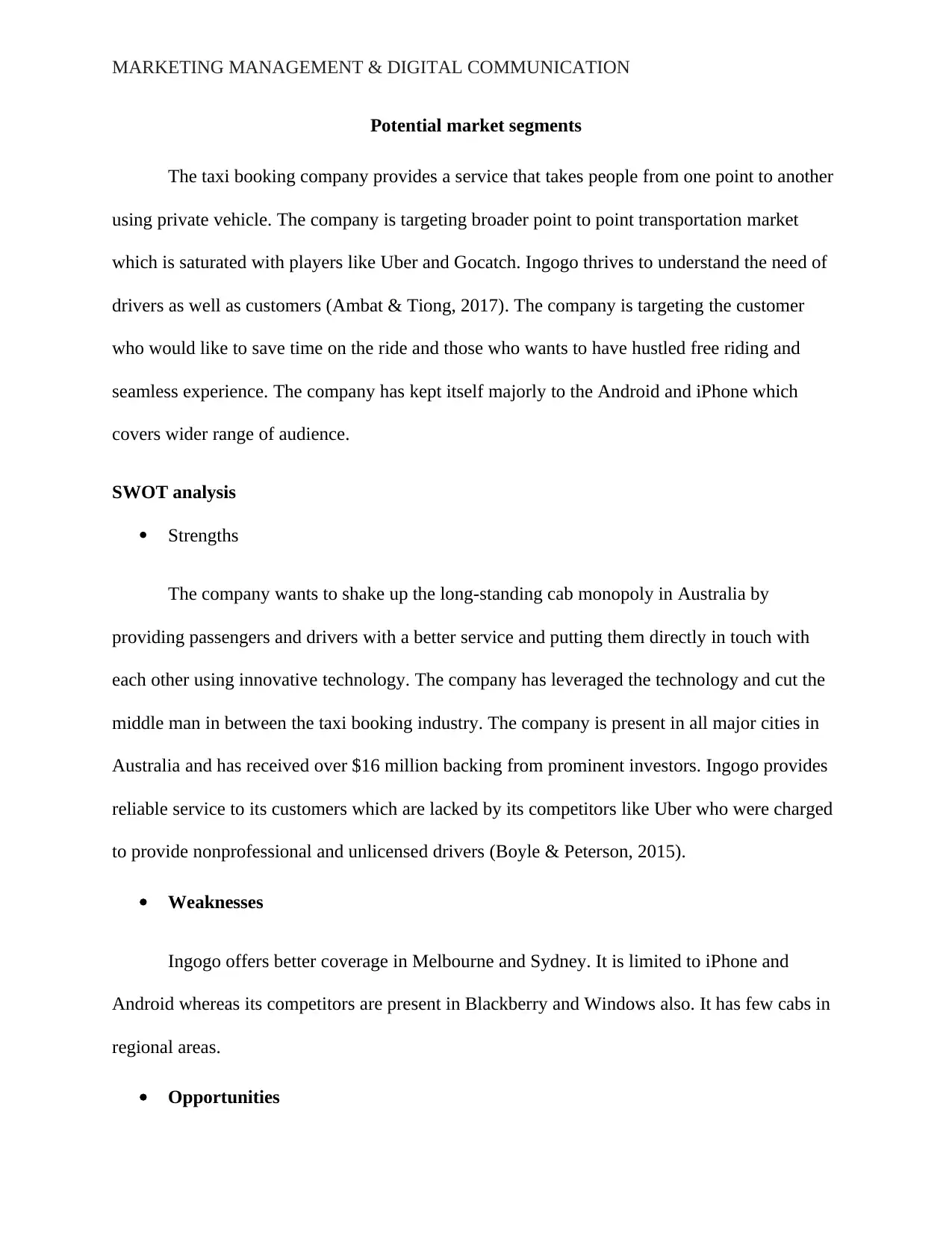
MARKETING MANAGEMENT & DIGITAL COMMUNICATION
Potential market segments
The taxi booking company provides a service that takes people from one point to another
using private vehicle. The company is targeting broader point to point transportation market
which is saturated with players like Uber and Gocatch. Ingogo thrives to understand the need of
drivers as well as customers (Ambat & Tiong, 2017). The company is targeting the customer
who would like to save time on the ride and those who wants to have hustled free riding and
seamless experience. The company has kept itself majorly to the Android and iPhone which
covers wider range of audience.
SWOT analysis
Strengths
The company wants to shake up the long-standing cab monopoly in Australia by
providing passengers and drivers with a better service and putting them directly in touch with
each other using innovative technology. The company has leveraged the technology and cut the
middle man in between the taxi booking industry. The company is present in all major cities in
Australia and has received over $16 million backing from prominent investors. Ingogo provides
reliable service to its customers which are lacked by its competitors like Uber who were charged
to provide nonprofessional and unlicensed drivers (Boyle & Peterson, 2015).
Weaknesses
Ingogo offers better coverage in Melbourne and Sydney. It is limited to iPhone and
Android whereas its competitors are present in Blackberry and Windows also. It has few cabs in
regional areas.
Opportunities
Potential market segments
The taxi booking company provides a service that takes people from one point to another
using private vehicle. The company is targeting broader point to point transportation market
which is saturated with players like Uber and Gocatch. Ingogo thrives to understand the need of
drivers as well as customers (Ambat & Tiong, 2017). The company is targeting the customer
who would like to save time on the ride and those who wants to have hustled free riding and
seamless experience. The company has kept itself majorly to the Android and iPhone which
covers wider range of audience.
SWOT analysis
Strengths
The company wants to shake up the long-standing cab monopoly in Australia by
providing passengers and drivers with a better service and putting them directly in touch with
each other using innovative technology. The company has leveraged the technology and cut the
middle man in between the taxi booking industry. The company is present in all major cities in
Australia and has received over $16 million backing from prominent investors. Ingogo provides
reliable service to its customers which are lacked by its competitors like Uber who were charged
to provide nonprofessional and unlicensed drivers (Boyle & Peterson, 2015).
Weaknesses
Ingogo offers better coverage in Melbourne and Sydney. It is limited to iPhone and
Android whereas its competitors are present in Blackberry and Windows also. It has few cabs in
regional areas.
Opportunities
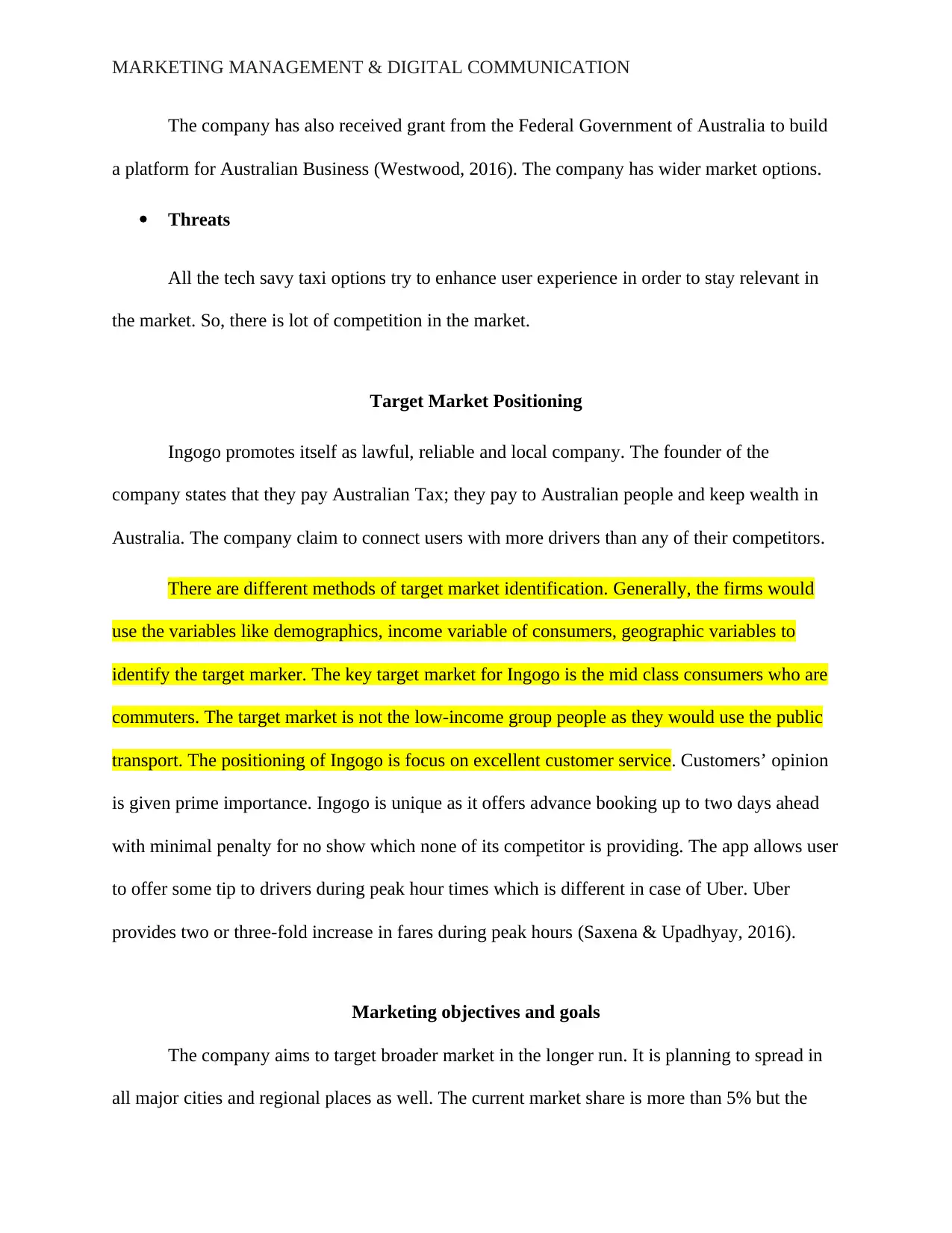
MARKETING MANAGEMENT & DIGITAL COMMUNICATION
The company has also received grant from the Federal Government of Australia to build
a platform for Australian Business (Westwood, 2016). The company has wider market options.
Threats
All the tech savy taxi options try to enhance user experience in order to stay relevant in
the market. So, there is lot of competition in the market.
Target Market Positioning
Ingogo promotes itself as lawful, reliable and local company. The founder of the
company states that they pay Australian Tax; they pay to Australian people and keep wealth in
Australia. The company claim to connect users with more drivers than any of their competitors.
There are different methods of target market identification. Generally, the firms would
use the variables like demographics, income variable of consumers, geographic variables to
identify the target marker. The key target market for Ingogo is the mid class consumers who are
commuters. The target market is not the low-income group people as they would use the public
transport. The positioning of Ingogo is focus on excellent customer service. Customers’ opinion
is given prime importance. Ingogo is unique as it offers advance booking up to two days ahead
with minimal penalty for no show which none of its competitor is providing. The app allows user
to offer some tip to drivers during peak hour times which is different in case of Uber. Uber
provides two or three-fold increase in fares during peak hours (Saxena & Upadhyay, 2016).
Marketing objectives and goals
The company aims to target broader market in the longer run. It is planning to spread in
all major cities and regional places as well. The current market share is more than 5% but the
The company has also received grant from the Federal Government of Australia to build
a platform for Australian Business (Westwood, 2016). The company has wider market options.
Threats
All the tech savy taxi options try to enhance user experience in order to stay relevant in
the market. So, there is lot of competition in the market.
Target Market Positioning
Ingogo promotes itself as lawful, reliable and local company. The founder of the
company states that they pay Australian Tax; they pay to Australian people and keep wealth in
Australia. The company claim to connect users with more drivers than any of their competitors.
There are different methods of target market identification. Generally, the firms would
use the variables like demographics, income variable of consumers, geographic variables to
identify the target marker. The key target market for Ingogo is the mid class consumers who are
commuters. The target market is not the low-income group people as they would use the public
transport. The positioning of Ingogo is focus on excellent customer service. Customers’ opinion
is given prime importance. Ingogo is unique as it offers advance booking up to two days ahead
with minimal penalty for no show which none of its competitor is providing. The app allows user
to offer some tip to drivers during peak hour times which is different in case of Uber. Uber
provides two or three-fold increase in fares during peak hours (Saxena & Upadhyay, 2016).
Marketing objectives and goals
The company aims to target broader market in the longer run. It is planning to spread in
all major cities and regional places as well. The current market share is more than 5% but the
Paraphrase This Document
Need a fresh take? Get an instant paraphrase of this document with our AI Paraphraser
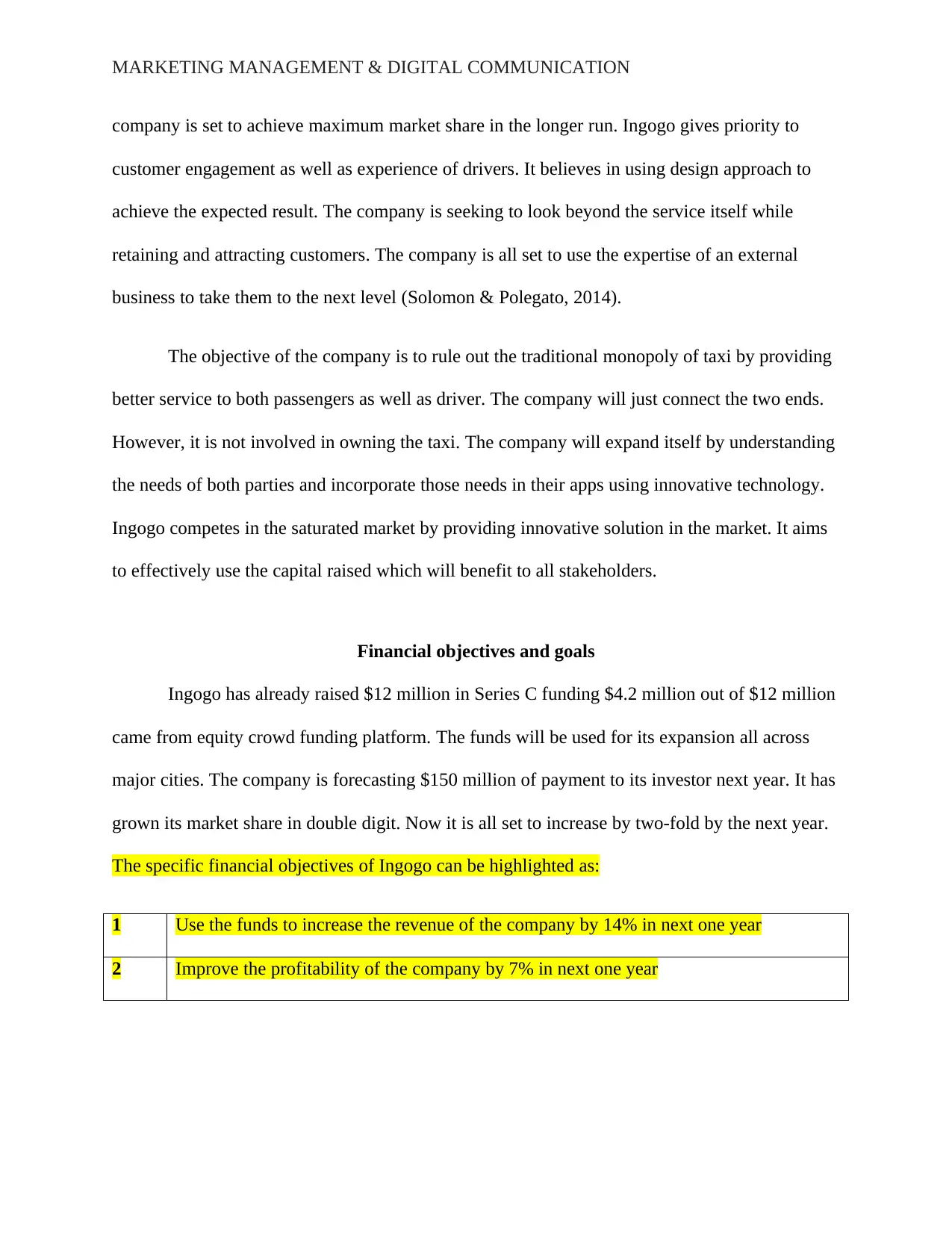
MARKETING MANAGEMENT & DIGITAL COMMUNICATION
company is set to achieve maximum market share in the longer run. Ingogo gives priority to
customer engagement as well as experience of drivers. It believes in using design approach to
achieve the expected result. The company is seeking to look beyond the service itself while
retaining and attracting customers. The company is all set to use the expertise of an external
business to take them to the next level (Solomon & Polegato, 2014).
The objective of the company is to rule out the traditional monopoly of taxi by providing
better service to both passengers as well as driver. The company will just connect the two ends.
However, it is not involved in owning the taxi. The company will expand itself by understanding
the needs of both parties and incorporate those needs in their apps using innovative technology.
Ingogo competes in the saturated market by providing innovative solution in the market. It aims
to effectively use the capital raised which will benefit to all stakeholders.
Financial objectives and goals
Ingogo has already raised $12 million in Series C funding $4.2 million out of $12 million
came from equity crowd funding platform. The funds will be used for its expansion all across
major cities. The company is forecasting $150 million of payment to its investor next year. It has
grown its market share in double digit. Now it is all set to increase by two-fold by the next year.
The specific financial objectives of Ingogo can be highlighted as:
1 Use the funds to increase the revenue of the company by 14% in next one year
2 Improve the profitability of the company by 7% in next one year
company is set to achieve maximum market share in the longer run. Ingogo gives priority to
customer engagement as well as experience of drivers. It believes in using design approach to
achieve the expected result. The company is seeking to look beyond the service itself while
retaining and attracting customers. The company is all set to use the expertise of an external
business to take them to the next level (Solomon & Polegato, 2014).
The objective of the company is to rule out the traditional monopoly of taxi by providing
better service to both passengers as well as driver. The company will just connect the two ends.
However, it is not involved in owning the taxi. The company will expand itself by understanding
the needs of both parties and incorporate those needs in their apps using innovative technology.
Ingogo competes in the saturated market by providing innovative solution in the market. It aims
to effectively use the capital raised which will benefit to all stakeholders.
Financial objectives and goals
Ingogo has already raised $12 million in Series C funding $4.2 million out of $12 million
came from equity crowd funding platform. The funds will be used for its expansion all across
major cities. The company is forecasting $150 million of payment to its investor next year. It has
grown its market share in double digit. Now it is all set to increase by two-fold by the next year.
The specific financial objectives of Ingogo can be highlighted as:
1 Use the funds to increase the revenue of the company by 14% in next one year
2 Improve the profitability of the company by 7% in next one year
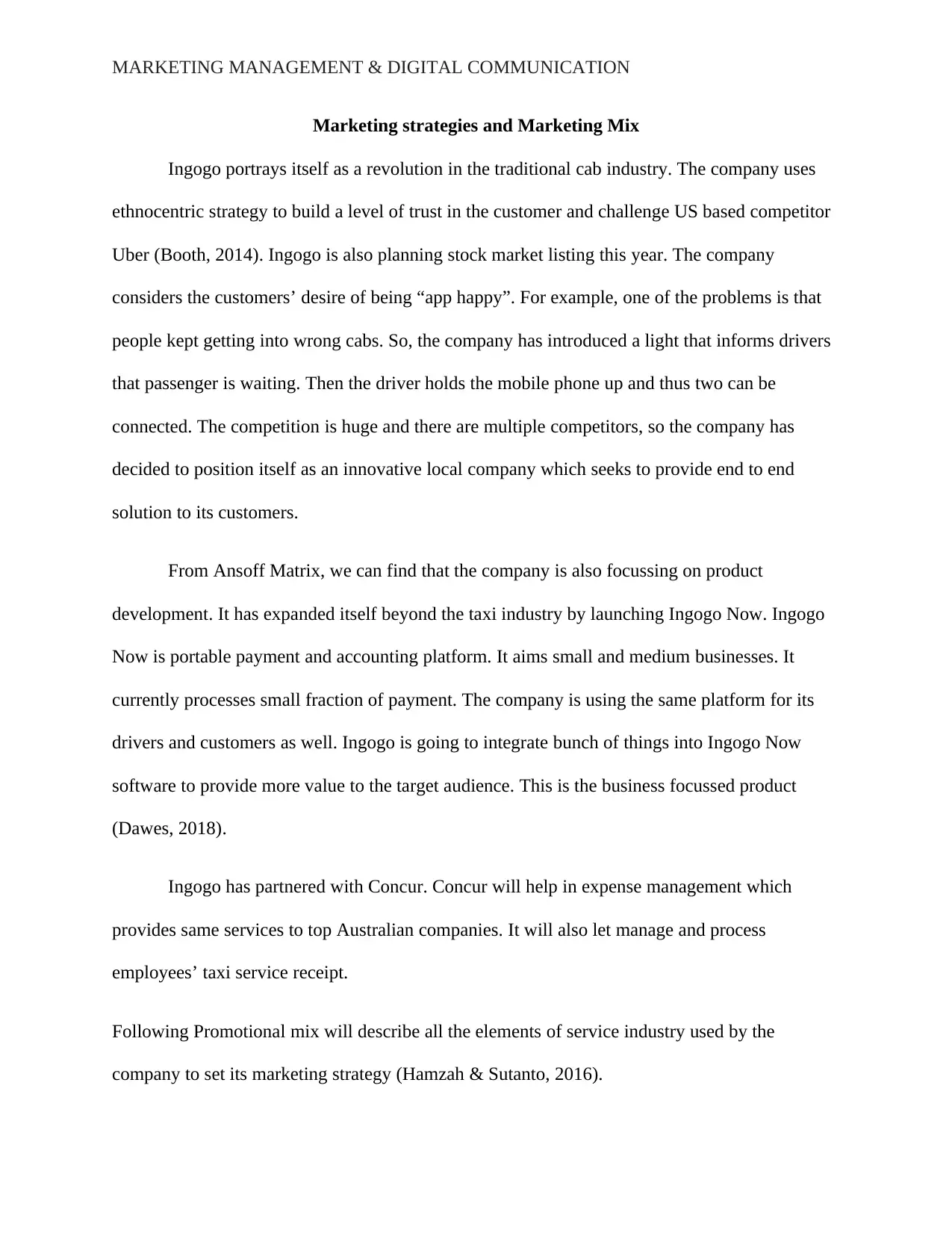
MARKETING MANAGEMENT & DIGITAL COMMUNICATION
Marketing strategies and Marketing Mix
Ingogo portrays itself as a revolution in the traditional cab industry. The company uses
ethnocentric strategy to build a level of trust in the customer and challenge US based competitor
Uber (Booth, 2014). Ingogo is also planning stock market listing this year. The company
considers the customers’ desire of being “app happy”. For example, one of the problems is that
people kept getting into wrong cabs. So, the company has introduced a light that informs drivers
that passenger is waiting. Then the driver holds the mobile phone up and thus two can be
connected. The competition is huge and there are multiple competitors, so the company has
decided to position itself as an innovative local company which seeks to provide end to end
solution to its customers.
From Ansoff Matrix, we can find that the company is also focussing on product
development. It has expanded itself beyond the taxi industry by launching Ingogo Now. Ingogo
Now is portable payment and accounting platform. It aims small and medium businesses. It
currently processes small fraction of payment. The company is using the same platform for its
drivers and customers as well. Ingogo is going to integrate bunch of things into Ingogo Now
software to provide more value to the target audience. This is the business focussed product
(Dawes, 2018).
Ingogo has partnered with Concur. Concur will help in expense management which
provides same services to top Australian companies. It will also let manage and process
employees’ taxi service receipt.
Following Promotional mix will describe all the elements of service industry used by the
company to set its marketing strategy (Hamzah & Sutanto, 2016).
Marketing strategies and Marketing Mix
Ingogo portrays itself as a revolution in the traditional cab industry. The company uses
ethnocentric strategy to build a level of trust in the customer and challenge US based competitor
Uber (Booth, 2014). Ingogo is also planning stock market listing this year. The company
considers the customers’ desire of being “app happy”. For example, one of the problems is that
people kept getting into wrong cabs. So, the company has introduced a light that informs drivers
that passenger is waiting. Then the driver holds the mobile phone up and thus two can be
connected. The competition is huge and there are multiple competitors, so the company has
decided to position itself as an innovative local company which seeks to provide end to end
solution to its customers.
From Ansoff Matrix, we can find that the company is also focussing on product
development. It has expanded itself beyond the taxi industry by launching Ingogo Now. Ingogo
Now is portable payment and accounting platform. It aims small and medium businesses. It
currently processes small fraction of payment. The company is using the same platform for its
drivers and customers as well. Ingogo is going to integrate bunch of things into Ingogo Now
software to provide more value to the target audience. This is the business focussed product
(Dawes, 2018).
Ingogo has partnered with Concur. Concur will help in expense management which
provides same services to top Australian companies. It will also let manage and process
employees’ taxi service receipt.
Following Promotional mix will describe all the elements of service industry used by the
company to set its marketing strategy (Hamzah & Sutanto, 2016).
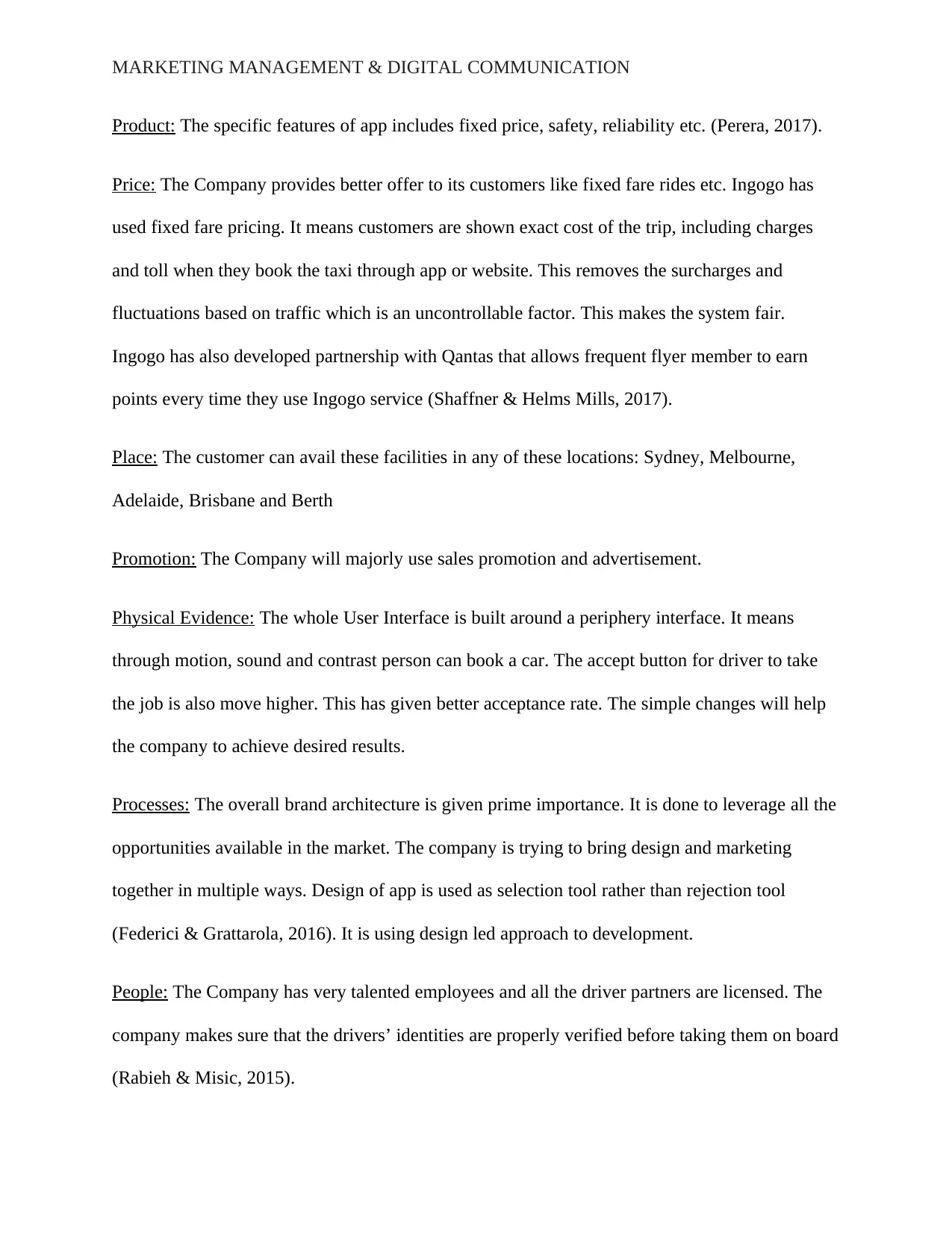
MARKETING MANAGEMENT & DIGITAL COMMUNICATION
Product: The specific features of app includes fixed price, safety, reliability etc. (Perera, 2017).
Price: The Company provides better offer to its customers like fixed fare rides etc. Ingogo has
used fixed fare pricing. It means customers are shown exact cost of the trip, including charges
and toll when they book the taxi through app or website. This removes the surcharges and
fluctuations based on traffic which is an uncontrollable factor. This makes the system fair.
Ingogo has also developed partnership with Qantas that allows frequent flyer member to earn
points every time they use Ingogo service (Shaffner & Helms Mills, 2017).
Place: The customer can avail these facilities in any of these locations: Sydney, Melbourne,
Adelaide, Brisbane and Berth
Promotion: The Company will majorly use sales promotion and advertisement.
Physical Evidence: The whole User Interface is built around a periphery interface. It means
through motion, sound and contrast person can book a car. The accept button for driver to take
the job is also move higher. This has given better acceptance rate. The simple changes will help
the company to achieve desired results.
Processes: The overall brand architecture is given prime importance. It is done to leverage all the
opportunities available in the market. The company is trying to bring design and marketing
together in multiple ways. Design of app is used as selection tool rather than rejection tool
(Federici & Grattarola, 2016). It is using design led approach to development.
People: The Company has very talented employees and all the driver partners are licensed. The
company makes sure that the drivers’ identities are properly verified before taking them on board
(Rabieh & Misic, 2015).
Product: The specific features of app includes fixed price, safety, reliability etc. (Perera, 2017).
Price: The Company provides better offer to its customers like fixed fare rides etc. Ingogo has
used fixed fare pricing. It means customers are shown exact cost of the trip, including charges
and toll when they book the taxi through app or website. This removes the surcharges and
fluctuations based on traffic which is an uncontrollable factor. This makes the system fair.
Ingogo has also developed partnership with Qantas that allows frequent flyer member to earn
points every time they use Ingogo service (Shaffner & Helms Mills, 2017).
Place: The customer can avail these facilities in any of these locations: Sydney, Melbourne,
Adelaide, Brisbane and Berth
Promotion: The Company will majorly use sales promotion and advertisement.
Physical Evidence: The whole User Interface is built around a periphery interface. It means
through motion, sound and contrast person can book a car. The accept button for driver to take
the job is also move higher. This has given better acceptance rate. The simple changes will help
the company to achieve desired results.
Processes: The overall brand architecture is given prime importance. It is done to leverage all the
opportunities available in the market. The company is trying to bring design and marketing
together in multiple ways. Design of app is used as selection tool rather than rejection tool
(Federici & Grattarola, 2016). It is using design led approach to development.
People: The Company has very talented employees and all the driver partners are licensed. The
company makes sure that the drivers’ identities are properly verified before taking them on board
(Rabieh & Misic, 2015).
Secure Best Marks with AI Grader
Need help grading? Try our AI Grader for instant feedback on your assignments.
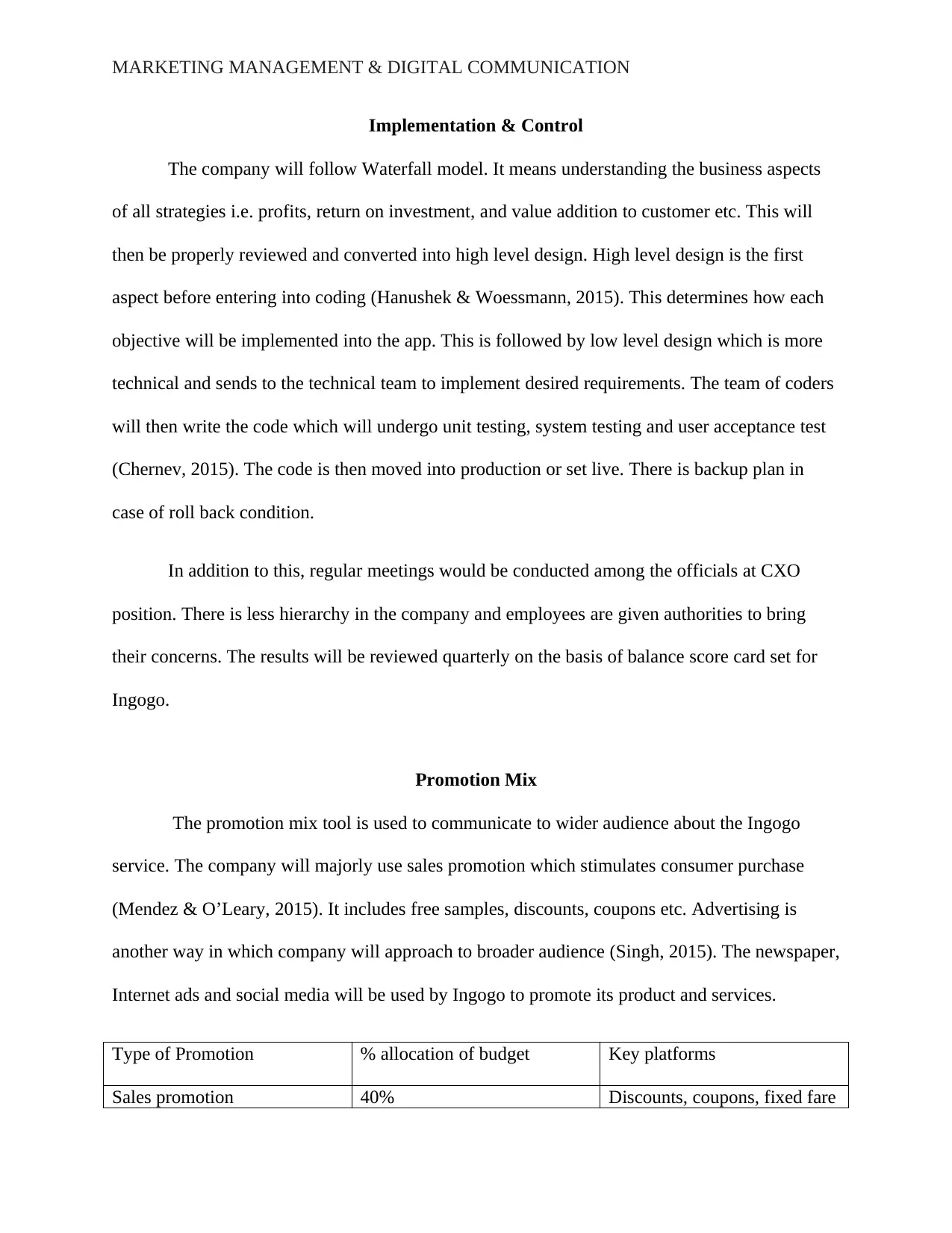
MARKETING MANAGEMENT & DIGITAL COMMUNICATION
Implementation & Control
The company will follow Waterfall model. It means understanding the business aspects
of all strategies i.e. profits, return on investment, and value addition to customer etc. This will
then be properly reviewed and converted into high level design. High level design is the first
aspect before entering into coding (Hanushek & Woessmann, 2015). This determines how each
objective will be implemented into the app. This is followed by low level design which is more
technical and sends to the technical team to implement desired requirements. The team of coders
will then write the code which will undergo unit testing, system testing and user acceptance test
(Chernev, 2015). The code is then moved into production or set live. There is backup plan in
case of roll back condition.
In addition to this, regular meetings would be conducted among the officials at CXO
position. There is less hierarchy in the company and employees are given authorities to bring
their concerns. The results will be reviewed quarterly on the basis of balance score card set for
Ingogo.
Promotion Mix
The promotion mix tool is used to communicate to wider audience about the Ingogo
service. The company will majorly use sales promotion which stimulates consumer purchase
(Mendez & O’Leary, 2015). It includes free samples, discounts, coupons etc. Advertising is
another way in which company will approach to broader audience (Singh, 2015). The newspaper,
Internet ads and social media will be used by Ingogo to promote its product and services.
Type of Promotion % allocation of budget Key platforms
Sales promotion 40% Discounts, coupons, fixed fare
Implementation & Control
The company will follow Waterfall model. It means understanding the business aspects
of all strategies i.e. profits, return on investment, and value addition to customer etc. This will
then be properly reviewed and converted into high level design. High level design is the first
aspect before entering into coding (Hanushek & Woessmann, 2015). This determines how each
objective will be implemented into the app. This is followed by low level design which is more
technical and sends to the technical team to implement desired requirements. The team of coders
will then write the code which will undergo unit testing, system testing and user acceptance test
(Chernev, 2015). The code is then moved into production or set live. There is backup plan in
case of roll back condition.
In addition to this, regular meetings would be conducted among the officials at CXO
position. There is less hierarchy in the company and employees are given authorities to bring
their concerns. The results will be reviewed quarterly on the basis of balance score card set for
Ingogo.
Promotion Mix
The promotion mix tool is used to communicate to wider audience about the Ingogo
service. The company will majorly use sales promotion which stimulates consumer purchase
(Mendez & O’Leary, 2015). It includes free samples, discounts, coupons etc. Advertising is
another way in which company will approach to broader audience (Singh, 2015). The newspaper,
Internet ads and social media will be used by Ingogo to promote its product and services.
Type of Promotion % allocation of budget Key platforms
Sales promotion 40% Discounts, coupons, fixed fare
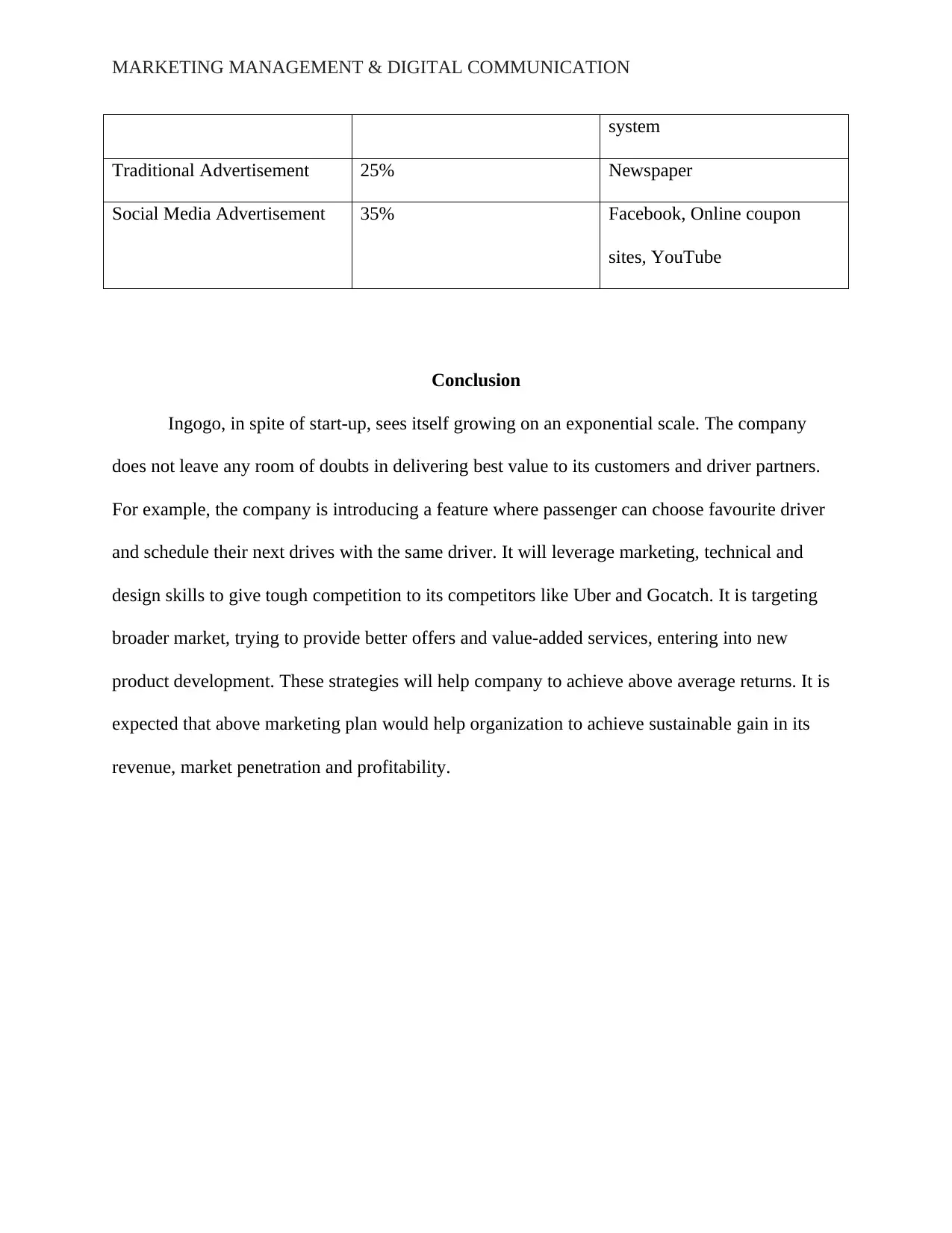
MARKETING MANAGEMENT & DIGITAL COMMUNICATION
system
Traditional Advertisement 25% Newspaper
Social Media Advertisement 35% Facebook, Online coupon
sites, YouTube
Conclusion
Ingogo, in spite of start-up, sees itself growing on an exponential scale. The company
does not leave any room of doubts in delivering best value to its customers and driver partners.
For example, the company is introducing a feature where passenger can choose favourite driver
and schedule their next drives with the same driver. It will leverage marketing, technical and
design skills to give tough competition to its competitors like Uber and Gocatch. It is targeting
broader market, trying to provide better offers and value-added services, entering into new
product development. These strategies will help company to achieve above average returns. It is
expected that above marketing plan would help organization to achieve sustainable gain in its
revenue, market penetration and profitability.
system
Traditional Advertisement 25% Newspaper
Social Media Advertisement 35% Facebook, Online coupon
sites, YouTube
Conclusion
Ingogo, in spite of start-up, sees itself growing on an exponential scale. The company
does not leave any room of doubts in delivering best value to its customers and driver partners.
For example, the company is introducing a feature where passenger can choose favourite driver
and schedule their next drives with the same driver. It will leverage marketing, technical and
design skills to give tough competition to its competitors like Uber and Gocatch. It is targeting
broader market, trying to provide better offers and value-added services, entering into new
product development. These strategies will help company to achieve above average returns. It is
expected that above marketing plan would help organization to achieve sustainable gain in its
revenue, market penetration and profitability.
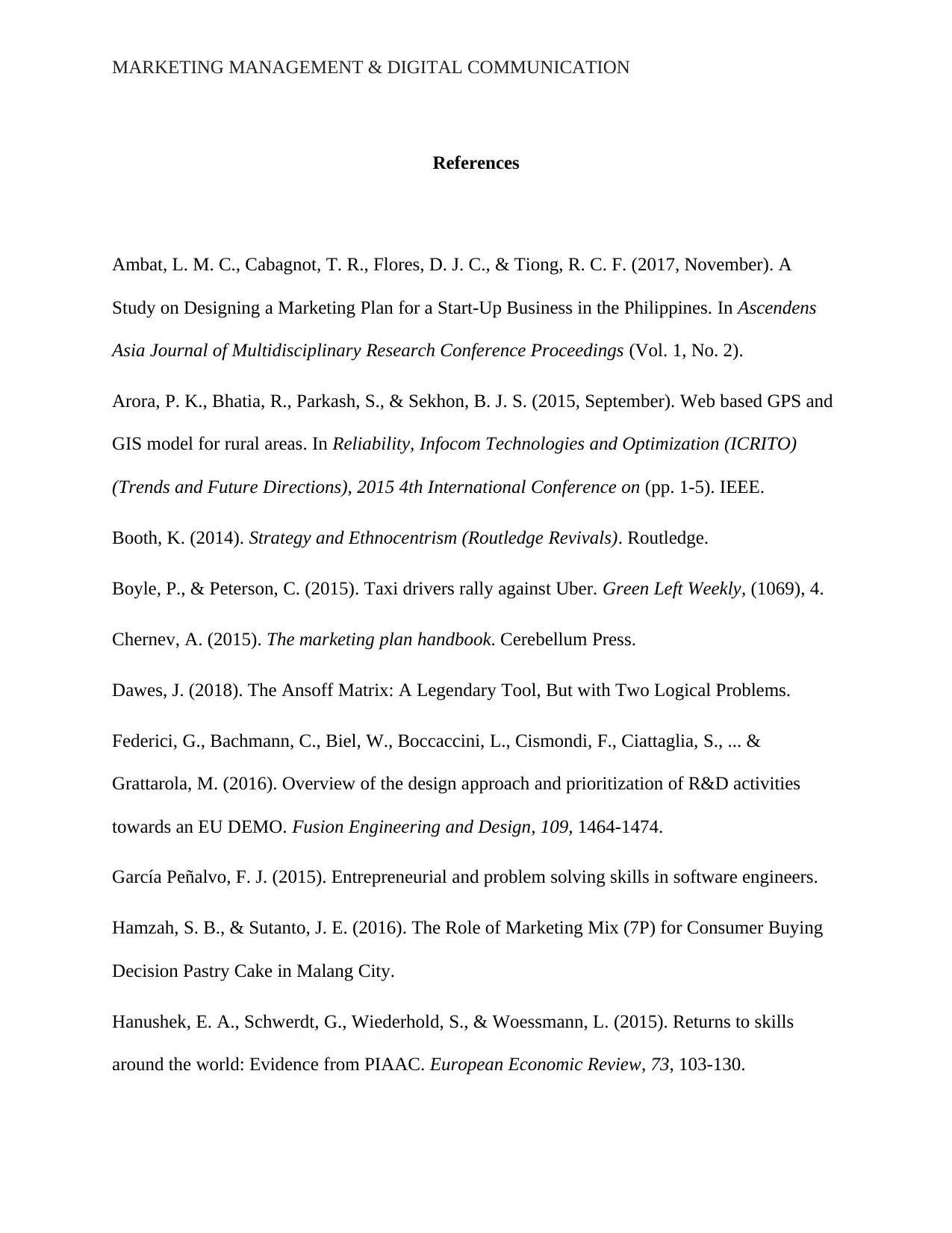
MARKETING MANAGEMENT & DIGITAL COMMUNICATION
References
Ambat, L. M. C., Cabagnot, T. R., Flores, D. J. C., & Tiong, R. C. F. (2017, November). A
Study on Designing a Marketing Plan for a Start-Up Business in the Philippines. In Ascendens
Asia Journal of Multidisciplinary Research Conference Proceedings (Vol. 1, No. 2).
Arora, P. K., Bhatia, R., Parkash, S., & Sekhon, B. J. S. (2015, September). Web based GPS and
GIS model for rural areas. In Reliability, Infocom Technologies and Optimization (ICRITO)
(Trends and Future Directions), 2015 4th International Conference on (pp. 1-5). IEEE.
Booth, K. (2014). Strategy and Ethnocentrism (Routledge Revivals). Routledge.
Boyle, P., & Peterson, C. (2015). Taxi drivers rally against Uber. Green Left Weekly, (1069), 4.
Chernev, A. (2015). The marketing plan handbook. Cerebellum Press.
Dawes, J. (2018). The Ansoff Matrix: A Legendary Tool, But with Two Logical Problems.
Federici, G., Bachmann, C., Biel, W., Boccaccini, L., Cismondi, F., Ciattaglia, S., ... &
Grattarola, M. (2016). Overview of the design approach and prioritization of R&D activities
towards an EU DEMO. Fusion Engineering and Design, 109, 1464-1474.
García Peñalvo, F. J. (2015). Entrepreneurial and problem solving skills in software engineers.
Hamzah, S. B., & Sutanto, J. E. (2016). The Role of Marketing Mix (7P) for Consumer Buying
Decision Pastry Cake in Malang City.
Hanushek, E. A., Schwerdt, G., Wiederhold, S., & Woessmann, L. (2015). Returns to skills
around the world: Evidence from PIAAC. European Economic Review, 73, 103-130.
References
Ambat, L. M. C., Cabagnot, T. R., Flores, D. J. C., & Tiong, R. C. F. (2017, November). A
Study on Designing a Marketing Plan for a Start-Up Business in the Philippines. In Ascendens
Asia Journal of Multidisciplinary Research Conference Proceedings (Vol. 1, No. 2).
Arora, P. K., Bhatia, R., Parkash, S., & Sekhon, B. J. S. (2015, September). Web based GPS and
GIS model for rural areas. In Reliability, Infocom Technologies and Optimization (ICRITO)
(Trends and Future Directions), 2015 4th International Conference on (pp. 1-5). IEEE.
Booth, K. (2014). Strategy and Ethnocentrism (Routledge Revivals). Routledge.
Boyle, P., & Peterson, C. (2015). Taxi drivers rally against Uber. Green Left Weekly, (1069), 4.
Chernev, A. (2015). The marketing plan handbook. Cerebellum Press.
Dawes, J. (2018). The Ansoff Matrix: A Legendary Tool, But with Two Logical Problems.
Federici, G., Bachmann, C., Biel, W., Boccaccini, L., Cismondi, F., Ciattaglia, S., ... &
Grattarola, M. (2016). Overview of the design approach and prioritization of R&D activities
towards an EU DEMO. Fusion Engineering and Design, 109, 1464-1474.
García Peñalvo, F. J. (2015). Entrepreneurial and problem solving skills in software engineers.
Hamzah, S. B., & Sutanto, J. E. (2016). The Role of Marketing Mix (7P) for Consumer Buying
Decision Pastry Cake in Malang City.
Hanushek, E. A., Schwerdt, G., Wiederhold, S., & Woessmann, L. (2015). Returns to skills
around the world: Evidence from PIAAC. European Economic Review, 73, 103-130.
Paraphrase This Document
Need a fresh take? Get an instant paraphrase of this document with our AI Paraphraser
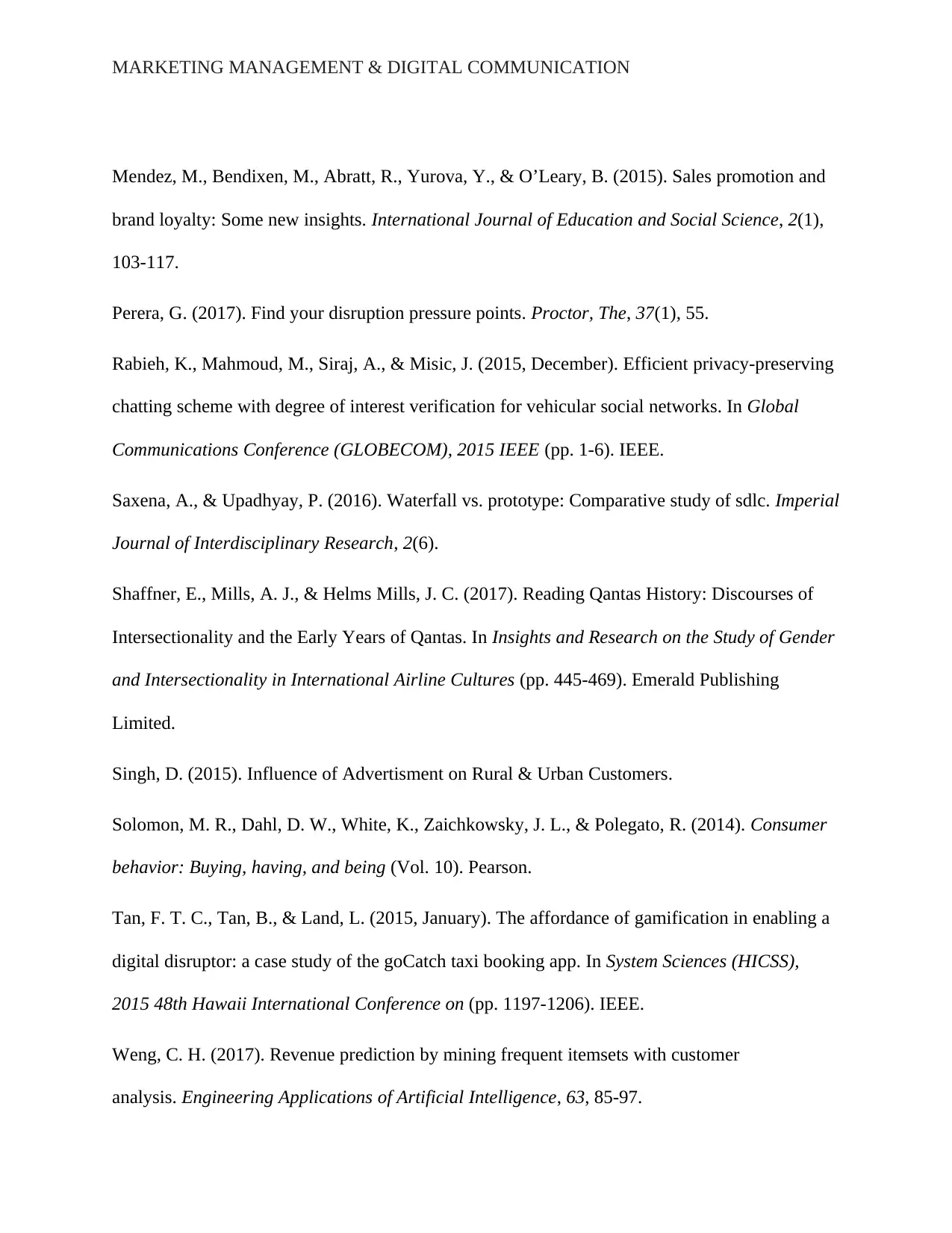
MARKETING MANAGEMENT & DIGITAL COMMUNICATION
Mendez, M., Bendixen, M., Abratt, R., Yurova, Y., & O’Leary, B. (2015). Sales promotion and
brand loyalty: Some new insights. International Journal of Education and Social Science, 2(1),
103-117.
Perera, G. (2017). Find your disruption pressure points. Proctor, The, 37(1), 55.
Rabieh, K., Mahmoud, M., Siraj, A., & Misic, J. (2015, December). Efficient privacy-preserving
chatting scheme with degree of interest verification for vehicular social networks. In Global
Communications Conference (GLOBECOM), 2015 IEEE (pp. 1-6). IEEE.
Saxena, A., & Upadhyay, P. (2016). Waterfall vs. prototype: Comparative study of sdlc. Imperial
Journal of Interdisciplinary Research, 2(6).
Shaffner, E., Mills, A. J., & Helms Mills, J. C. (2017). Reading Qantas History: Discourses of
Intersectionality and the Early Years of Qantas. In Insights and Research on the Study of Gender
and Intersectionality in International Airline Cultures (pp. 445-469). Emerald Publishing
Limited.
Singh, D. (2015). Influence of Advertisment on Rural & Urban Customers.
Solomon, M. R., Dahl, D. W., White, K., Zaichkowsky, J. L., & Polegato, R. (2014). Consumer
behavior: Buying, having, and being (Vol. 10). Pearson.
Tan, F. T. C., Tan, B., & Land, L. (2015, January). The affordance of gamification in enabling a
digital disruptor: a case study of the goCatch taxi booking app. In System Sciences (HICSS),
2015 48th Hawaii International Conference on (pp. 1197-1206). IEEE.
Weng, C. H. (2017). Revenue prediction by mining frequent itemsets with customer
analysis. Engineering Applications of Artificial Intelligence, 63, 85-97.
Mendez, M., Bendixen, M., Abratt, R., Yurova, Y., & O’Leary, B. (2015). Sales promotion and
brand loyalty: Some new insights. International Journal of Education and Social Science, 2(1),
103-117.
Perera, G. (2017). Find your disruption pressure points. Proctor, The, 37(1), 55.
Rabieh, K., Mahmoud, M., Siraj, A., & Misic, J. (2015, December). Efficient privacy-preserving
chatting scheme with degree of interest verification for vehicular social networks. In Global
Communications Conference (GLOBECOM), 2015 IEEE (pp. 1-6). IEEE.
Saxena, A., & Upadhyay, P. (2016). Waterfall vs. prototype: Comparative study of sdlc. Imperial
Journal of Interdisciplinary Research, 2(6).
Shaffner, E., Mills, A. J., & Helms Mills, J. C. (2017). Reading Qantas History: Discourses of
Intersectionality and the Early Years of Qantas. In Insights and Research on the Study of Gender
and Intersectionality in International Airline Cultures (pp. 445-469). Emerald Publishing
Limited.
Singh, D. (2015). Influence of Advertisment on Rural & Urban Customers.
Solomon, M. R., Dahl, D. W., White, K., Zaichkowsky, J. L., & Polegato, R. (2014). Consumer
behavior: Buying, having, and being (Vol. 10). Pearson.
Tan, F. T. C., Tan, B., & Land, L. (2015, January). The affordance of gamification in enabling a
digital disruptor: a case study of the goCatch taxi booking app. In System Sciences (HICSS),
2015 48th Hawaii International Conference on (pp. 1197-1206). IEEE.
Weng, C. H. (2017). Revenue prediction by mining frequent itemsets with customer
analysis. Engineering Applications of Artificial Intelligence, 63, 85-97.
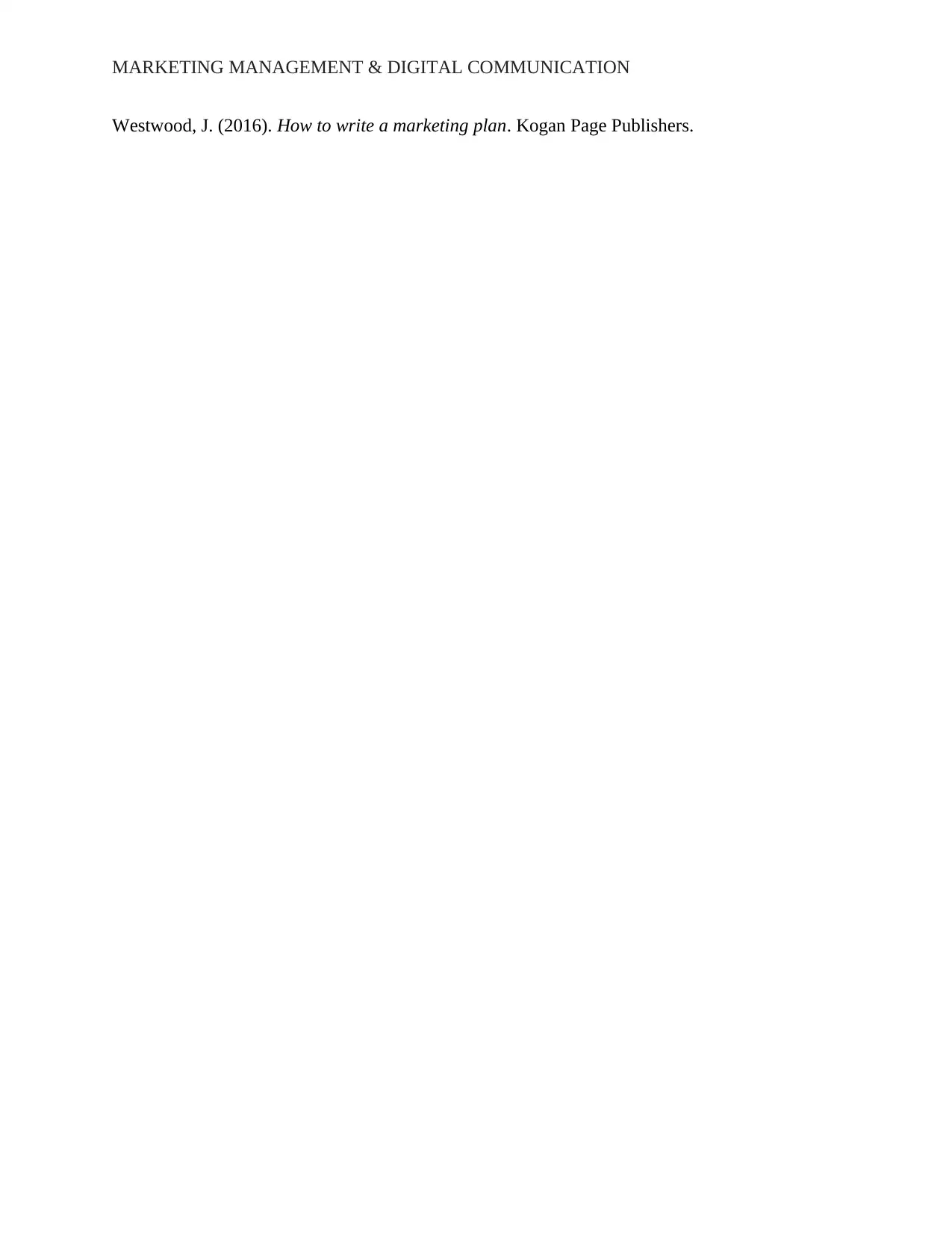
MARKETING MANAGEMENT & DIGITAL COMMUNICATION
Westwood, J. (2016). How to write a marketing plan. Kogan Page Publishers.
Westwood, J. (2016). How to write a marketing plan. Kogan Page Publishers.
1 out of 15
Related Documents
Your All-in-One AI-Powered Toolkit for Academic Success.
+13062052269
info@desklib.com
Available 24*7 on WhatsApp / Email
![[object Object]](/_next/static/media/star-bottom.7253800d.svg)
Unlock your academic potential
© 2024 | Zucol Services PVT LTD | All rights reserved.





